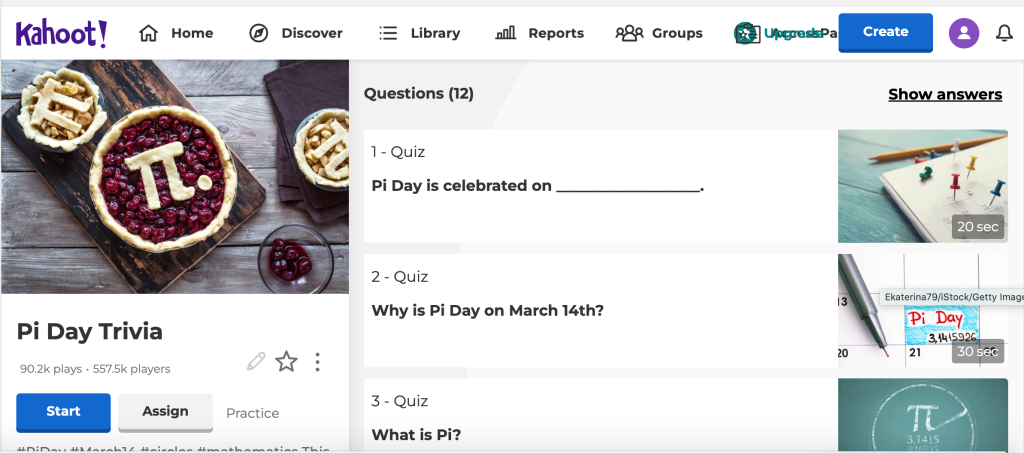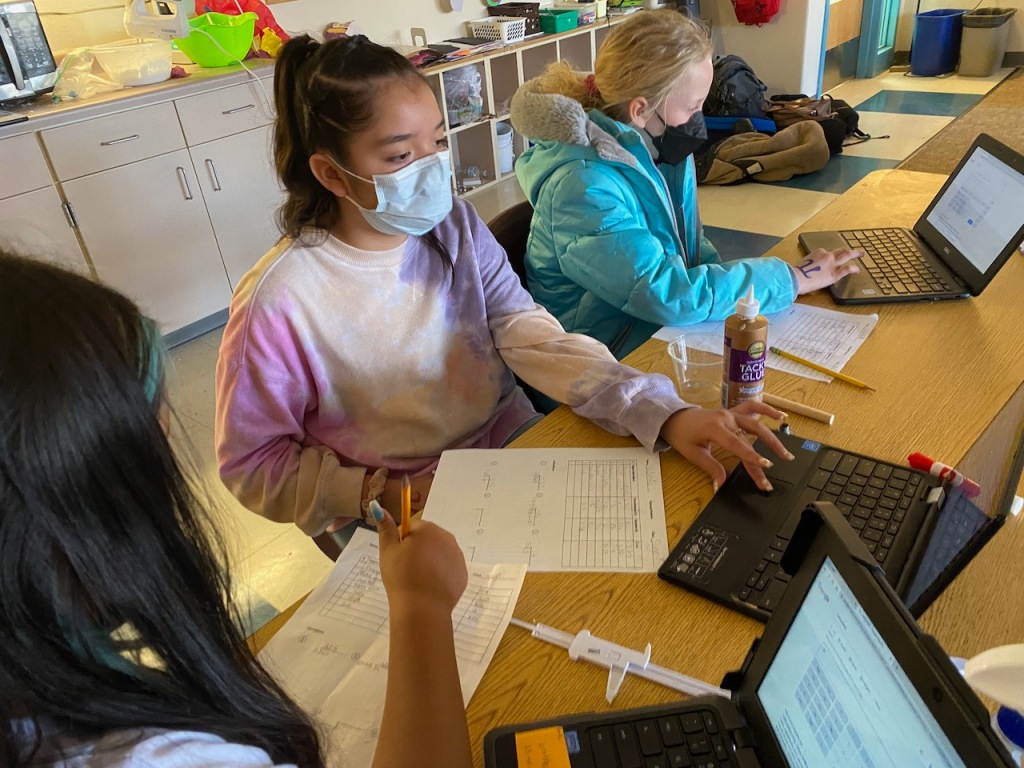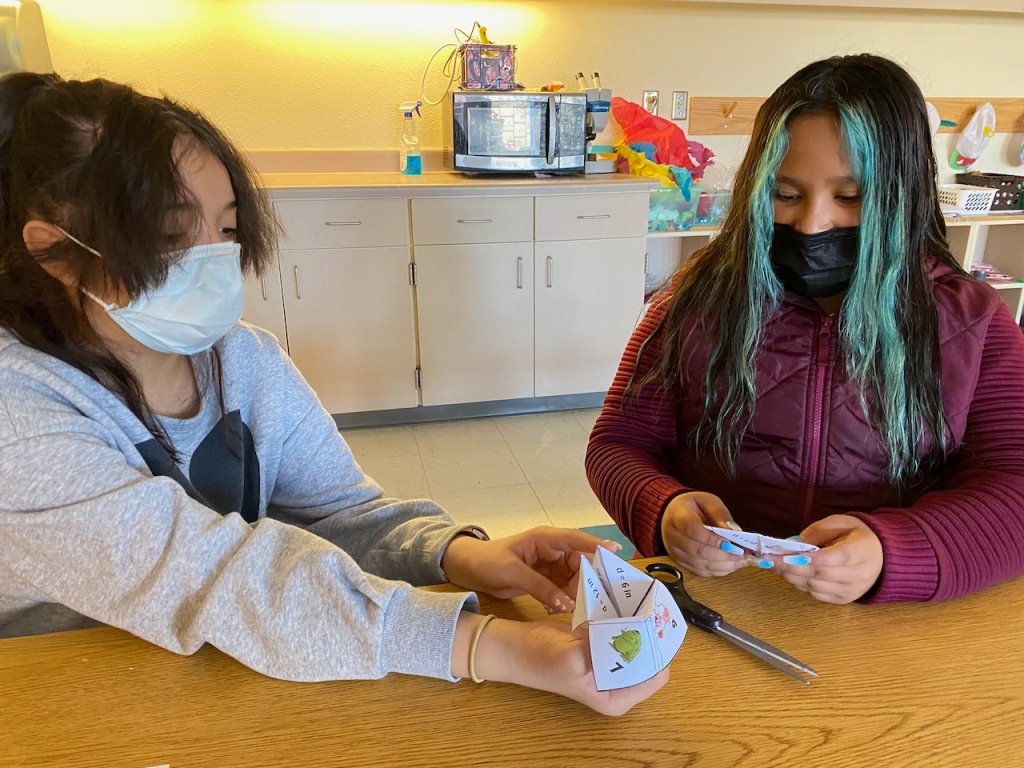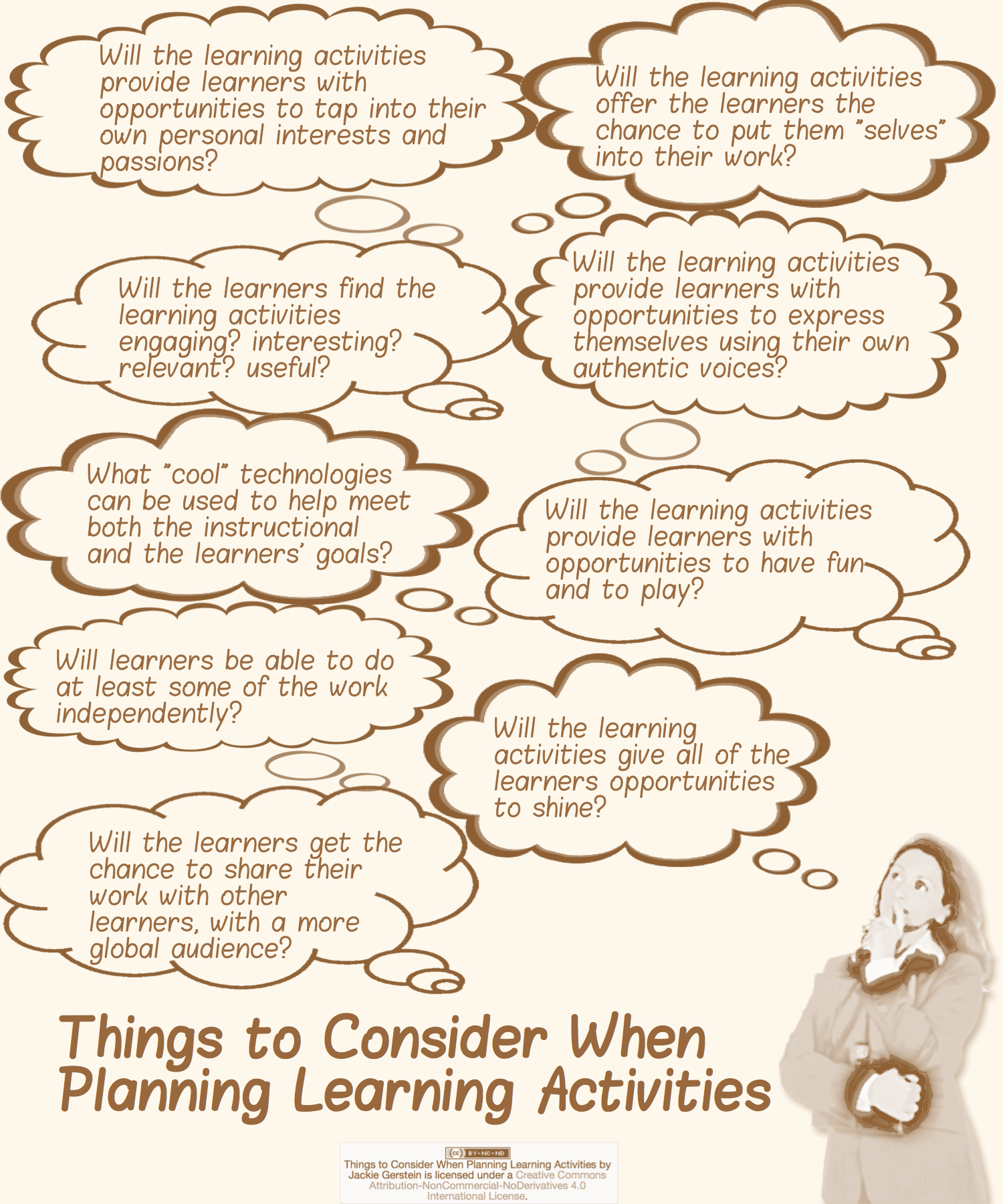Posts Tagged ‘lesson planning’
Pi Day: An Example of an Interdisciplinary, Engaging Lesson
I have the privilege of teaching my gifted elementary students at two Title 1 schools for multiple years. Each year I have special thematic days for which the students get very excited, e.g., Halloween and Day of the Dead “Wars,” Valentines Day, Book Celebrations, and Pi Day. I love planning a variety of interdisciplinary activities for these days. It is like planning parties. I want to give them memories of positive school experiences that last a lifetime. When I announce these upcoming celebrations, the students who have been in my program for multiple years cheer loudly. My new students then get excited, too.
I’ve blogged about the value of interdisciplinary units before – All Lessons Should Be Interdisciplinary https://usergeneratededucation.wordpress.com/2019/01/13/all-lessons-should-be-interdisciplinary/

Pi Day Activities
The day consisted of the following activities:
- Introduction – Pi Day Trivia
- Book: Sir Cumference
- Kahoot Pi Games
- Digital Breakout
- Making and Decorating Pies
- Measuring for Pi
- Stations
- Pi Fortune Teller
- Pi Sky Line
- Race to Pi Card Game
Standards Addressed
A variety of cross-disciplinary content standards were addressed during this lesson.
Common Core Math Standards:
- CCSS.MATH.CONTENT.7.G.B.4
Know the formulas for the area and circumference of a circle and use them to solve problems; give an informal derivation of the relationship between the circumference and area of a circle. - CCSS.MATH.CONTENT.5.MD.A.1
Convert among different-sized standard measurement units within a given measurement system, and use these conversions in solving multi-step, real world problems.
Common Core English Language Arts Standards:
- CCSS.ELA-LITERACY.RI.6.7
Integrate information presented in different media or formats (e.g., visually, quantitatively) as well as in words to develop a coherent understanding of a topic or issue. - CCSS.ELA-LITERACY.RI.5.10
By the end of the year, read and comprehend informational texts, including history/social studies, science, and technical texts, at the high end of the grades 4-5 text complexity band independently and proficiently.
National Core Art Standards:
- Generate and conceptualize artistic ideas and work.
- Refine and complete artistic work. (https://www.nationalartsstandards.org/)
Pi Day Trivia
Students were introduced to Pi and Pi Day through the following videos:
Sir Cumference
The students then were shown a reading of Sir Cumference and the First Round Table (A Math Adventure) by Cindy Neuschwander:
Join Sir Cumference, Lady Di of Ameter, and their son Radius for wordplay, puns, and problem solving in this geometry-packed math adventure. King Arthur was a good ruler, but now he needs a good ruler. What would you do if the neighboring kingdom were threatening war? Naturally, you’d call your strongest and bravest knights together to come up with a solution. But when your conference table causes more problems than the threat of your enemy, you need expert help. Enter Sir Cumference, his wife Lady Di of Ameter, and their son Radius. With the help of the carpenter, Geo of Metry, this sharp-minded team designs the perfect table conducive to discussing the perfect plan for peace (https://www.amazon.com/Cumference-First-Round-Table-Adventure/dp/1570911525).
Pi Kahoots
My students cheer when we do Kahoot quizzes. The Kahoot quizzes made and submitted by other teachers make it so easy to use. Here are the two Pi Kahoots I did with the students:

Accessed at: https://create.kahoot.it/details/0210be57-ce68-489a-9054-d9165b8165ff

Accessed at: https://create.kahoot.it/details/pi-day-trivia/a7605cd3-4c93-4c13-bc23-eec96da2a627
Digital Breakout EDU – Pi Day
Breakout EDU is an immersive learning games platform. Breakout EDU games consist of a combination of physical and digital puzzle elements that must be solved in a set amount of time. Players of all ages are challenged to open the locked Breakout EDU box using critical thinking, collaboration and creativity. (https://orrhslibrary.weebly.com/what-is-breakout-edu.html).
Here is the Pi Day Digital Breakout EDU game they did.

Can be accessed at https://platform.breakoutedu.com/game/play/pi-day-digital-breakout-4th-6th-grades-90608 .
Making and Decorating Pies



One of the activities students enjoy the most during Pi day is making pies. They were given ingredients and recipes for:
- Oreo Cookie Pie – https://littlespoonfarm.com/no-bake-lemon-icebox-pie-recipe/
- Lemon Pie – https://littlespoonfarm.com/no-bake-lemon-icebox-pie-recipe/
- Strawberry – https://www.justapinch.com/recipes/dessert/pie/strawberry-icebox-pie.html
- Graham cracker crust (for use in the Pi pan) – https://www.callmepmc.com/how-to-make-a-no-bake-graham-cracker-crust/
- Royal Icing (for decorating the pies) – https://www.chsugar.com/recipe/royal-icing-with-meringue-powder
They needed to follow the recipe which included figuring out the directions and using measurements. I even bought a Pi pan for them to use. After the pies were made, they decorated them with Pi symbols and characters.
Measuring for Pi
With tape measures in hand, groups of students carefully measure the circumferences and diameters of various round objects. The class makes a table of measured values and calculates the quotients. When they see time and time again the same answer result from division, whether it be from big circular objects or small ones—eureka!—they will have unwittingly discovered π for themselves (http://ccssimath.blogspot.com/2013/03/the-life-of-pi.html).
I created a competition to see which team could achieve Pi based on their measurements of diameters and circumferences of real world objects. I watched as they struggled with and learning about circumferences, diameters, and pi; about doing accurate measurement; about converting fractions into decimals to do their calculations; and about using the Pi formula.
Stations
Students could choose from the following stations to complete their Pi days.
Pi Fortune Teller
Pi Graph Skyline
Directions for this activity can be found at https://carrotsareorange.com/pi-day-activities/.
Race to Pi Card Game
Directions can be found at https://mathgeekmama.com/pi-day-card-game/.
Pi Day: An Example of an Interdisciplinary, Engaging Lesson
I have the privilege of teaching my gifted elementary students for multiple years. At my one school, I have them in class for a full day each week, and each year I have special thematic days for which the students get very excited, e.g., Halloween and Day of the Dead “Wars,” Valentines Day, Book Celebrations, and Pi Day. I love planning a variety of interdisciplinary activities for these days and I love watching how 100% are fully engaged for the entire time.
I’ve blogged about the value of interdisciplinary units before – All Lessons Should Be Interdisciplinary https://usergeneratededucation.wordpress.com/2019/01/13/all-lessons-should-be-interdisciplinary/

Pi Day Activities
The day consisted of the following activities:
- Digital Breakout
- Making and Decorating Pies
- Book: Sir Cumference
- Measuring for Pi
- Kahoot Pi Games
Standards Addressed
Common Core Math Standards:
- CCSS.MATH.CONTENT.7.G.B.4
Know the formulas for the area and circumference of a circle and use them to solve problems; give an informal derivation of the relationship between the circumference and area of a circle. - CCSS.MATH.CONTENT.5.MD.A.1
Convert among different-sized standard measurement units within a given measurement system, and use these conversions in solving multi-step, real world problems.
Common Core English Language Arts Standards:
- CCSS.ELA-LITERACY.RI.6.7
Integrate information presented in different media or formats (e.g., visually, quantitatively) as well as in words to develop a coherent understanding of a topic or issue. - CCSS.ELA-LITERACY.RI.5.10
By the end of the year, read and comprehend informational texts, including history/social studies, science, and technical texts, at the high end of the grades 4-5 text complexity band independently and proficiently.
ISTE Standards for Students:
- Students plan and employ effective research strategies to locate information and other resources for their intellectual or creative pursuits.
- Students collect data or identify relevant data sets, use digital tools to analyze them, and represent data in various ways to facilitate problem-solving and decision-making.
21st Partnership for 21st Century Skills:
- Collaborate with others
- Demonstrate ability to work effectively and respectfully with diverse teams
- Exercise flexibility and willingness to be helpful in making necessary compromises to accomplish a common goal
- Assume shared responsibility for collaborative work, and value the individual contributions made by each team member
Digital Breakout EDU – Pi Day
So what is this about Digital Breakout EDU games? Simply put, it’s taking the same concept, but turning it all digital. Participants are given a one-page site that includes text, images and links to clues, some of which may be misleading. There is a Google Form embedded on the page where you submit your answers to a series of “lock” questions and each lock will immediately tell you if you’re successful (http://wordpress.barrow.k12.ga.us/21stcenturytips/?p=6989).
To start off our Pi day activities, students did a Pi Day Digital Breakout EDU game.

Can be accessed at https://platform.breakoutedu.com/game/play/pi-day-digital-breakout-4th-6th-grades-90608 .
Making and Decorating Pies


One of the activities students enjoy the most during Pi day is making pies. They were given ingredients and recipes for:
- Apple Pie – https://www.thespruceeats.com/easy-apple-pie-recipe-for-kids-2097625
- Chocolate Peanut Butter Pie – https://happyhourprojects.com/chocolate-peanut-butter-pies/
- Royal Icing (for decorating the pies) – https://www.chsugar.com/recipe/royal-icing-with-meringue-powder
They needed to follow the recipe which included figuring out the directions and using measurements. After the pies were made, they decorated them with Pi symbols.
Sir Cumference
The students then were shown a reading of Sir Cumference and the First Round Table (A Math Adventure) by Cindy Neuschwander:
Join Sir Cumference, Lady Di of Ameter, and their son Radius for wordplay, puns, and problem solving in this geometry-packed math adventure. King Arthur was a good ruler, but now he needs a good ruler. What would you do if the neighboring kingdom were threatening war? Naturally, you’d call your strongest and bravest knights together to come up with a solution. But when your conference table causes more problems than the threat of your enemy, you need expert help. Enter Sir Cumference, his wife Lady Di of Ameter, and their son Radius. With the help of the carpenter, Geo of Metry, this sharp-minded team designs the perfect table conducive to discussing the perfect plan for peace (https://www.amazon.com/Cumference-First-Round-Table-Adventure/dp/1570911525).
Measuring for Pi


With tape measures in hand, groups of students carefully measure the circumferences and diameters of various round objects. The class makes a table of measured values and calculates the quotients. When they see time and time again the same answer result from division, whether it be from big circular objects or small ones—eureka!—they will have unwittingly discovered π for themselves (http://ccssimath.blogspot.com/2013/03/the-life-of-pi.html).
Pi Kahoots
Using Kahoot wasn’t planned for the day but the students asked for it. I love that they ask for learning tasks. The Kahoot quizzes made and submitted by other teachers make it so easy to use them spontaneously. Here are the two Pi Kahoots I did with the students:

Accessed at: https://create.kahoot.it/details/pi-day/877d64ee-3003-4a30-9d82-f1cd81721749

Accessed at: https://create.kahoot.it/details/pi-day-trivia/a7605cd3-4c93-4c13-bc23-eec96da2a627
Integrating Maker Education into the Curriculum
Rather than the maker experiences being an after school program, an add on activity, or an activity that is implemented when students have done their regular lessons work, it should be part of the regular, day-to-day curriculum. As noted in USC Rossier Online, “In order for your school and students to be fully invested in maker education, it has to be integrated into your curriculum, not squeezed in” (https://rossieronline.usc.edu/maker-education/sync-with-curriculum/). Ayah Bdeir, who invented and runs littleBits, had this to say about integrating maker education into the curriculum:
It’s time for maker ed to move into the mainstream. Making should not be relegated to the times spent outside of class, e.g. lunch or after school. Nor should it only flourish in private schools, which don’t have to teach to standards. We need to work to show how making is a rigorous process that leads to valuable new technologies, products and experiences. Specifically, we need to tie maker projects to standards-based curriculum and show clearly the kinds of knowledge, skills and practices students learn as part of making (https://www.edsurge.com/news/2015-09-24-building-connections-between-maker-ed-and-standards)
Albemarle County Public School District is very intentional in their implementation of maker projects:
Maker projects can be created to support just about any subject area, from science to history to language arts. Maker education can be a tool for teaching the curriculum that you already have, At a glance, maker projects may appear disconnected from the curriculum. What may look like an arts and crafts activity, or just a bunch of kids playing with Legos, is actually a way to teach about ancient Rome or how to write a persuasive essay. (https://www.edutopia.org/practice/maker-education-reaching-all-learners)
To do this, though, the educator needs to approach his or her curriculum and lessons with a maker mindset. With this mindset, he or she figures out creative ways to integrate maker activities into existing lessons and instructional activities. The educator in these situations starts with the standards and objectives of their lessons, as they typically do with their regular lessons, and then designs and/or locates maker activities that fit the lesson. It simply becomes, “How can I add a making element to my lessons to reinforce concepts being learned?”
For subjects like science, this is a little easier as the labs that often accompany science lessons often have a hint of STEM or maker education. With a little tweaking, these labs can become more of a maker education type of activity. For example, if students are learning about circuits, they could wire cardboard model houses with lights and fans.
For subjects like language arts, this integration is a little more challenging but with a little creativity, it is possible and exciting. An example is Tufts University Center for Engineering Education and Outreach’s program, Novel Engineering:
Novel Engineering is an innovative approach to integrate engineering and literacy in elementary and middle school. Students use existing classroom literature – stories, novels, and expository texts – as the basis for engineering design challenges that help them identify problems, design realistic solutions, and engage in the Engineering Design Process while reinforcing their literacy skills.
Example books that offer engineering or maker education challenges include:
- The Long Walk to Water – http://www.novelengineering.org/project/long-walk-to-water/
- Island of Blue Dolphins – http://www.novelengineering.org/project/island-of-the-blue-dolphins/
- James and the Giant Peach – http://www.novelengineering.org/project/james-and-the-giant-peach/
- The Invention of Hugo Cabret – http://www.novelengineering.org/project/the-invention-of-hugo-cabret/
- Tuck Everlasting – http://www.novelengineering.org/project/tuck-everlasting/
- The Three Little Javelinas – http://www.novelengineering.org/project/the-three-little-javelinas/
The benefits of this type of curriculum integration include all those benefits described for maker education, in general, but also include:
- Increased learner interest in and engagement with content rich lesson activities.
- Lesson activities may become a gateway to content areas for learners who may not have been interested in that content area in the past. For example, making in language arts may spark a STEM interest for students who have previously only been interested in language arts; spark the interest of STEM-oriented students in language arts.
To help integrate maker education into the curriculum, I developed the following lesson plan template to assist teachers with this process.

Example Maker Education Lesson Plan
Vision for this Lesson and for Student Learning (What is the overarching purpose of this lesson? How does making enhance the lesson? Consider relevancy, authenticity, transfer to other life situations):
Student Voice (What are the interests and needs of the students? How is their voice incorporated into the development of this lesson?):
Standards Addressed (Think cross-curriculum and 21st century skills; think process as well as content learnings):
- Science Standards (see the Next Generation Science Standards at https://www.nextgenscience.org/ or your state standards):
- Math Standards (see Common Core Standards for Mathematical Practice at http://www.corestandards.org/Math/Practice/ or your state standards)
- Language Arts Standards (see Common Core English Language Arts Standards at http://www.corestandards.org/ELA-Literacy/ or your state standards):
- Social Studies Standards (see the National Curriculum Standards for Social Studies at https://www.socialstudies.org/standards or your state standards):
- Arts Standards (see the National Core Arts Standards at http://www.nationalartsstandards.org/ or your state standards):
- ISTE Standards for Students (for detailed descriptions and sub-standards, see https://www.iste.org/standards/for-students):
- Empowered Learner: Students leverage technology to take an active role in choosing, achieving and demonstrating competency in their learning goals, informed by the learning sciences.
-
- Digital Citizen: Students recognize the rights, responsibilities and opportunities of living, learning and working in an interconnected digital world, and they act and model in ways that are safe, legal and ethical.
-
- Knowledge Constructor: Students critically curate a variety of resources using digital tools to construct knowledge, produce creative artifacts and make meaningful learning experiences for themselves and others.
-
- Innovative Designer: Students use a variety of technologies within a design process to identify and solve problems by creating new, useful or imaginative solutions.
-
- Computational Thinker: Students develop and employ strategies for understanding and solving problems in ways that leverage the power of technological methods to develop and test solutions.
-
- Creative Communicator: Students communicate clearly and express themselves creatively for a variety of purposes using the platforms, tools, styles, formats and digital media appropriate to their goals.
-
- Global Collaborator: Students use digital tools to broaden their perspectives and enrich their learning by collaborating with others and working effectively in teams locally and globally.
- 21st Century Skills (see for detailed descriptions at http://www.p21.org/our-work/p21-framework to add specifics):
- Global Awareness: _________________________________________________
- Financial, Economic: _______________________________________________
- Business and Entrepreneurial Literacy: _________________________________
- Civic Literacy: _____________________________________________________
- Health Literacy: ___________________________________________________
- Environmental Literacy: _____________________________________________
- Creativity and Innovation: ___________________________________________
- Critical Thinking and Problem Solving: _________________________________
- Communication: ___________________________________________________
- Collaboration: _____________________________________________________
- Information Literacy: _______________________________________________
- Media Literacy: ____________________________________________________
- ICT Literacy: ______________________________________________________
- Flexibility and Adaptability: ___________________________________________
- Initiative and Self-Direction: __________________________________________
- Social and Cross-Cultural Skills: ______________________________________
- Productivity and Accountability: _______________________________________
- Leadership and Responsibility: _______________________________________
Lesson Challenge Statement – Framing the Experience: (How will the maker lesson be framed or frontloaded? – What is the big challenge for this activity? What essential questions do you want learners to explore? What overarching concepts do you want learners to investigate? Is the challenge open and ill-defined so there are multiple opportunities for student interpretation, innovation, and creativity?) The maker lesson can be framed or frontloaded through:
- Introducing Essential Questions
- The Use of Scenarios
- Specifying the Standards
- Asking Questions Related To Personal Skills
- Asking Questions to Help with Scaffolding and Sequencing the Activities
- Asking Questions Related To Using Peer Support-Working Collaboratively
(More information about frontloading the maker experience can be found at https://usergeneratededucation.wordpress.com/2016/03/16/framing-and-frontloading-maker-activities/)
Required Prerequisite Knowledge and Skills:
Vocabulary: (What vocabulary do you want learners to learn and use?)
Getting Started: (What high impact activity will you do to get learners excited about or hooked into the upcoming lesson?)
- Video: _________________________________________________________________
- Hands-On Demonstration: _________________________________________________
- AR/VR Simulation: _______________________________________________________
- Online Virtual Simulation: _________________________________________________
- Live Guest Speaker (in person or via Skype/Google Hangout): ____________________
- Game (analog or digital): __________________________________________________
- Group Discussion About the Learning Challenge
Tinkering and Exploration: (Will the learners benefit with some free-play tinkering with and exploring the materials?)
Skills and Knowledge Direct Instruction: (What, if any, knowledge and skills do you need to teach directly prior to the maker activity?)
Learner Planning Time: Time for learners to research and plan what they will do for the maker challenge.
Learner Creation Time: Time for the learners to create, to try out several iterations of their ideas, if needed.
Learner Sharing and Feedback Time: Time for learners to share what they are making with their peers; whose role then is to give feedback.
Documenting Learning and Reflection: How will learners document and reflect on their learning? Possible reflection questions include:
- What new skills have you learned because of the maker experience?
- What are the most important learning moments you take with you from this maker experience?
- Would you do this or a similar maker project again? Why or why not?
- Has this maker experience changed you? If yes, how?
- Describe what you have learned about yourself as a result of your maker experience.
- What would you like to change about your maker experience?
- What were the benefits from you participating in this making activity?
- What surprised you the most during your maker experience?
- What did you do that seemed to be effective?
- What did you do that seemed to be ineffective?
- What were the most difficult parts of the maker experience? Why?
- What were the most satisfying parts of the maker experience? Why?
- What personal characteristics made this maker experience successful for you?
- Describe an awareness about a personal characteristic that has been enhanced by your maker experience.
- How does the maker experience relate to your long-term goals?
- How have you been challenged during the maker experience?
- How do you feel about what you made? What parts of it do you particularly like? Dislike?
- What lessons can you learn from the maker experience?
- What positives can you take away from the maker experience?
- How can you apply what you learned from maker experience in your life?
- What advice would you give to someone else working on the maker activities?
- What did you learn through this experience and how can you use it in the future?
- Looking back on the maker experience, what two things stand out to you the most and why?
(For more on reflecting on the maker experience, see https://usergeneratededucation.wordpress.com/2018/03/10/reflecting-on-maker-experiences-with-reflection-cards/.)
Assessment: How will learners be assessed? (This is especially important in a school setting where grades and accountability are expected.)
- Rubric – Based on Standards and Objectives
- Teacher Generated
- Student Generated
- Portfolio Artifact
- Submitted to a Blog
- Submitted to a web platform like Seesaw
- Peer Assessments
Sharing Out Findings: How will learners share out what they learned with a larger maker education community? Adam Savage of Mythbusters fame stated: Sharing is s a vital aspect of maker culture that is intrinsic to the underlying ethos of what it means to be a maker and by extension, in my opinion, a human being (https://boingboing.net/2018/05/23/adam-savage-at-maker-faire-th.html).
- Use of Social Media?
- Presentations to Local Students and Community Members?
- News Coverage?
- Teaching Others?
Questions to Ask Oneself While Designing Learning Activities
I absolutely love planning lessons from scratch. I just got a job teaching technology units for a summer camp for elementary age students. I can design and teach whatever I want – planning for a different theme each week. Some of the themes I am planning are: Expanding and Showing Your Personal Interests Through Blogging, Photos, and Videos; Coding and Creating Online Games; Tinkering and Making – Simple Robotics; Hacking Your Notebook; and Creating Online Comics, Newspapers, and Magazines. I have begun the process of planning these classes through reflecting on what the lessons will look like. Here are some questions I ask myself as I go through this process:
- Will the learning activities provide learners with opportunities to tap into their own personal interests and passions?
- Will the learning activities offer the learners the chance to put them “selves” into their work?
- Will the learning activities provide learners with opportunities to express themselves using their own authentic voices?
- Will the learners find the learning activities engaging? interesting? relevant? useful?
- What “cool” technologies can be used to help meet both the instructional and the learners’ goals?
- Will the learning activities provide learners with opportunities to have fun and to play?
- Will learners be able to do at least some of the work independently?
- Will the learning activities give all of the learners opportunities to shine?
- Will the learners get the chance to share their work with other learners, with a more global audience?













